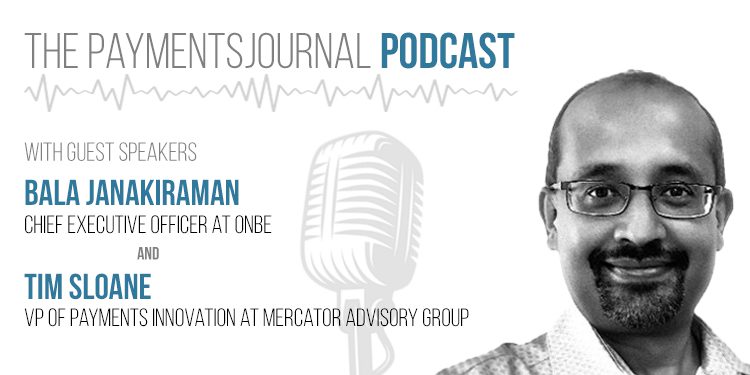The digital, on-demand nature of today’s world is changing the way consumers engage with brands and businesses – and what they expect in return – especially when it comes to payments. The pandemic has only fueled these changes. Simply put, when it comes to receiving payments of any type – rebates, refunds, compensation, etc. – consumers want choice, speed, and convenience. For businesses, the challenge is how to adapt their payments operations to stay relevant and responsive.
Onbe’s recent Future of Payments 2022 survey uncovered disbursement trends and preferences among businesses and consumers, including the generational adoption of newer paytech. The survey also looks at who is moving away from slow and costly legacy payment methods, like checks, and whether cryptocurrencies are becoming as mainstream as the buzz indicates.
To learn more about the future of payments, PaymentsJournal sat down with Bala Janakiraman, Chief Executive Officer at Onbe, and Tim Sloane, VP of Payments Innovation at Mercator Advisory Group.
Reasons consumers receive disbursements
According to Onbe’s Future of Payments survey, there are four main reasons consumers receive disbursements:
- Payments for work (74%) – Compensation received by an employee (i.e., an employee paycheck) or a gig economy contractor.
- Consumer refunds (46%) – Funds that are returned to a consumer in the form of a disbursement, such as a reimbursement for an overpayment.
- Purchase incentives (41%) – Rebates and promotional savings attached to specific items.
- Government payments (39%) – Stimulus payments, particularly as a result of the COVID-19 pandemic, as well as disability, unemployment, social security, and childcare tax credits.
Employee compensation is by far the most common form of disbursement. According to Sloane, the relationship between employer and employee is changing as the gig economy expands.
“The ability for the employer to provide wages earlier can connect [payments] directly to the work that they are doing, right down to a particular task that they need to finish in order to receive compensation,” Sloane explained. This benefits both parties by both expediting payments and clarifying their purpose.
“There is a key advantage to accelerated payments,” Janakiraman noted. “Efficient payment management has positive implications both internally in terms of lower costs and increased compliance, and externally in terms of creating the best possible customer/worker experience at every touch point.”
Speed, choice, and convenience
There are a range of other beneficial options for improved payments experiences. Incentives make a world of difference for worker productivity when disbursed at the time of the task, compared to incentives disbursed, say, ten hours after the fact. New P2P tools are also driving choice, allowing consumers to link payments to their debit card.
Regardless of what method consumers prefer at any given time, the goal is offering them a fast and flexible payments solution. “Consumers have a variety of means to interact with the real world today,” noted Janakiraman. Brands need to be aware of how the recipients of their disbursement want to get paid, how soon they want to get paid, and what technology choices beyond checks and payroll enterprises can be deployed to provide a satisfying recipient experience.
“Whether they want to get the payment straight to their debit card through a push to debit, or they want it straight to their mobile wallet so that right after they get paid,” Janakiraman continued, “they want to go out and transact. So, the choice factor is becoming more and more important.”
The tricky crypto space
One of the most talked-about new payment choices is cryptocurrency. Younger demographics are more keen to experiment with crypto; the number of 18-24-year-olds intending to use crypto doubled between 2020-2021, but cryptocurrency is still not considered a mainstream payment method.
“We can see tremendous interest in crypto as an asset,” Sloane clarified. “Payments, on the other hand, is a lot trickier and is still an evolving area.” Crypto exchanges, merchant acquirers, and card networks are all working their way around the burgeoning crypto market, and acceptance is slowly growing.
How and when crypto will arrive at mass market adoption remains to be seen, but it certainly warrants close attention. “If you provide crypto as a disbursement option, [you] should not be surprised that there will be several takers.” The imperative comes in part from an “asset-based mindset,” where consumers can cut out the step of purchasing crypto themselves and just receive it directly.
Paytech adoption trends
“Everything that we have seen in payments for the last couple of years has been the march towards more digitization,” emphasized Janakiraman. This is not to say that checks are going to vanish off the face of the earth, but brands absolutely should keep consumer preferences in mind, because old-fashioned disbursement methods such as paper checks are not instant and do not drive choice.
No matter how you slice it, there is certainly a growing desire to receive payments in a digital fashion, whether via digital wallets or P2P transactions. “At the point of disbursement, a ‘one size fits all’ approach is less likely to create a satisfying consumer and recipient experience,” Janakiraman concluded. “That is something for brands and enterprises to keep in mind as they evaluate [their] disbursement strategy for what is emerging to be a fascinating future in payments.”










